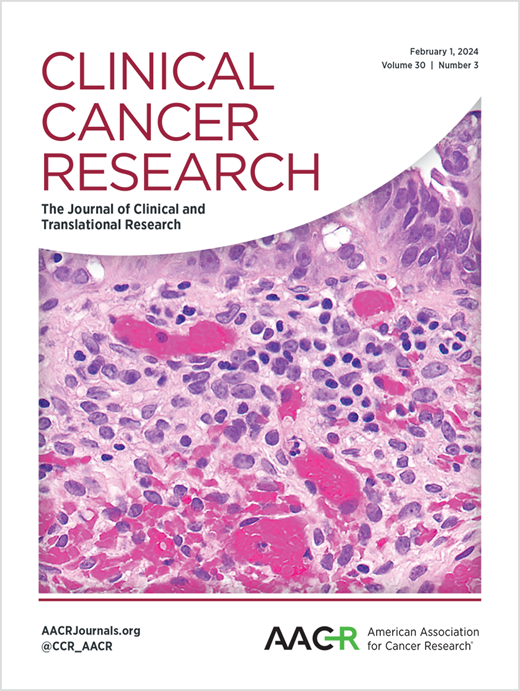Prognostic significance and predictive value of circulating tumor cells in invasive lobular breast carcinoma - an exploratory analysis of the STIC CTC trial.
IF 10.2
1区 医学
Q1 ONCOLOGY
引用次数: 0
Abstract
PURPOSE In patients with metastatic breast cancer (MBC), ≥5 circulating tumor cells (CTC)/7.5mL of blood is a validated adverse prognostic marker. The STIC CTC phase III trial (N=778, HR+ HER2- MBC) showed that ≥5 CTC/7.5mL before treatment predicted greater benefit from first-line chemotherapy over endocrine therapy for progression-free (PFS) and overall survival (OS). This exploratory analysis examines these results by histological subtype, comparing invasive lobular carcinoma (ILC) and carcinoma of no special type (NST). PATIENTS AND METHODS Baseline CTC count (CellSearch®) and its impact on PFS and OS were compared between ILC (N=159) and NST (N=571). The survival benefit of chemotherapy in patients with high CTC counts was then re-evaluated separately for each subtype. RESULTS Before treatment, ILC had significantly higher CTC counts than NST (median: 10 [Q1=2, Q3=40] vs. 1 [Q1=0, Q3=7]). ≥5 CTC/7.5mL was found in 64% (95%CI [56-71]) of ILC and 31% (95%CI [28-35]) of NST patients, correlating with shorter PFS and OS in both. However, ILC patients with ≥5 CTC/7.5mL saw no significant benefit from CTC-informed chemotherapy (PFS: HR=0.91 [0.55-1.52]; OS: HR=0.83 [0.46-1.52]). In contrast, NST patients with ≥5 CTC/7.5mL had markedly improved outcomes with chemotherapy (PFS: HR=0.54 [0.37-0.81]; OS: HR=0.37 [0.21-0.66]). CONCLUSIONS ILC shed more CTCs than NST, likely due to biological differences. While the ≥5 CTC/7.5mL threshold remained a valid prognostic marker for both, it was predictive of chemotherapy benefit in NST, but not ILC. These findings highlight differences in biomarker utility between ILC and NST, affecting both threshold relevance and treatment response.浸润性小叶性乳腺癌循环肿瘤细胞的预后意义及预测价值——STIC CTC试验的探索性分析
目的:在转移性乳腺癌(MBC)患者中,血液循环肿瘤细胞(CTC)≥5 /7.5mL是一个有效的不良预后指标。STIC CTC III期试验(N=778, HR+ HER2- MBC)显示,治疗前≥5 CTC/7.5mL预测一线化疗比内分泌治疗在无进展(PFS)和总生存期(OS)方面获益更大。本探索性分析通过组织学亚型来检验这些结果,比较浸润性小叶癌(ILC)和无特殊类型癌(NST)。患者和方法比较ILC (N=159)和NST (N=571)的基线CTC计数(CellSearch®)及其对PFS和OS的影响。然后对每个亚型的高CTC计数患者重新评估化疗的生存获益。结果治疗前,ILC的CTC计数明显高于NST(中位数:10 [Q1=2, Q3=40] vs. 1 [Q1=0, Q3=7])。64% (95%CI[56-71])的ILC和31% (95%CI[28-35])的NST患者≥5 CTC/7.5mL,两者均与较短的PFS和OS相关。然而,CTC/7.5mL≥5的ILC患者从CTC知情化疗中没有明显获益(PFS: HR=0.91 [0.55-1.52]; OS: HR=0.83[0.46-1.52])。相比之下,≥5 CTC/7.5mL的NST患者化疗后预后明显改善(PFS: HR=0.54 [0.37-0.81]; OS: HR=0.37[0.21-0.66])。结论silc比NST脱落的CTCs更多,可能与生物学差异有关。虽然≥5 CTC/7.5mL阈值仍然是两者的有效预后指标,但它可以预测NST的化疗获益,但不能预测ILC。这些发现强调了ILC和NST之间生物标志物效用的差异,影响阈值相关性和治疗反应。
本文章由计算机程序翻译,如有差异,请以英文原文为准。
求助全文
约1分钟内获得全文
求助全文
来源期刊

Clinical Cancer Research
医学-肿瘤学
CiteScore
20.10
自引率
1.70%
发文量
1207
审稿时长
2.1 months
期刊介绍:
Clinical Cancer Research is a journal focusing on groundbreaking research in cancer, specifically in the areas where the laboratory and the clinic intersect. Our primary interest lies in clinical trials that investigate novel treatments, accompanied by research on pharmacology, molecular alterations, and biomarkers that can predict response or resistance to these treatments. Furthermore, we prioritize laboratory and animal studies that explore new drugs and targeted agents with the potential to advance to clinical trials. We also encourage research on targetable mechanisms of cancer development, progression, and metastasis.
 求助内容:
求助内容: 应助结果提醒方式:
应助结果提醒方式:


